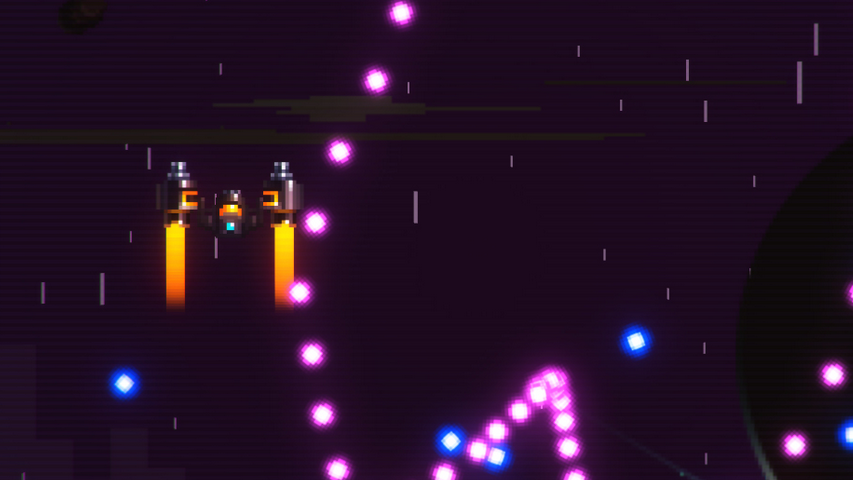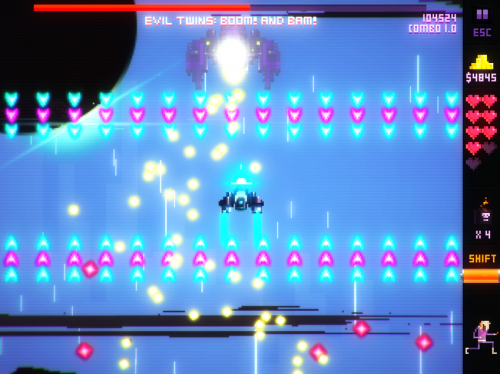App2Top.ru begins a new cycle of materials dedicated to developments that have not yet been released, but have already reached the playable phase. The first project to hit our desktop was – Beat the Beat.
In 2001, the French duet Daft Punk, which today more or less everyone knows from Get Lucky and Lose Yourself to Dance, released the album Discovery. All his compositions received an animation clip connected by a single plot. Two years later, they came out as a full-fledged tape “Interstella 5555”, telling about the abduction of musicians from another planet by an insidious manager from Earth.
Beat the Beat by 2Players and Nekki is a Discovery that has acquired a game, a music album, and at the same time a full-fledged scrolling shooter, which work so well in a single bundle that they give birth to a very rare, very valuable phenomenon within the market – an artistic product.
Another thing is that, despite the publishers’ assurances that the project is almost ready and it can be released soon, I believe that the game, which may well become one of the main indie releases of this year (under “indie” I don’t mean independent, but individual, that is, special, original), needs to be refined, cut.
Mechanics
The developers themselves position their game as a mix of the genres Bullet hell (a subcategory of shoot ’em up a la Space Invaders, but more complex and aggressive, characterized by the need to leave at the same time not from one or two shots, but from tens or hundreds) and Rhythm game.
But, it seems to me, it would not be a fundamental mistake to also attribute the game to vertical scrolling shooters, especially since this genre is also referred to as one of the types of “shvamp”.
The game session begins approximately as follows: the player chooses the difficulty level, spends the available game currency on any improvements and starts the game.
During the session itself, the user controls a small spaceship, attacks enemy ships and dodges their numerous shots. After each level with ordinary opponents, there is a level in which there is only a boss fight.
In general, as already mentioned, at the first approximation of mechanics, this is quite a familiar scrolling shooter. The key feature of the project is its musical accompaniment and the connection between the tracks and what is happening on the screen.
The fact is that the opponents’ shots are carried out in time with the playing musical composition. Since each level in the game has its own accompaniment, the levels are perceived, despite the visual similarity, as very individual game components.
Thanks to this, Beat the Beat can be safely called a game musical.
By the way, as far as I understand, due to the binding of attacks and the music of some enemies in the game are unkillable (their attacks just need to survive). Otherwise, the compositions would be devoid of visual accompaniment.
Another experience from the game to some extent can be compared to watching a trailer in which the visual cut is well adjusted to the sounding composition. Of course, with the difference that under this cutting you need to dodge shots.
In terms of mechanics, there were only two things that confused us in the game.
The first: as with classic arcade machines, it is impossible to choose the desired level. Any game session starts from the very beginning. However, if you start from the chosen genre, this is a classic solution that significantly increases the duration of the game. By the way, for those who want to listen to their favorite track, the Practice mode is provided. You won’t earn money in it and you won’t go to the next level, but you will play to your favorite song.
Second: in scroll shooters, destroyed enemies, as a rule, leave behind any temporary bonuses. From the point of view of game design, the introduction of bonuses increases the role of the game economy, but, of course, only if it allows you to pump their duration and effectiveness for game currency. For players, these are pleasant and unexpected things that diversify the gameplay. Conditionally, this is an element of a slot machine in the game. Unfortunately, in Beat the Beat, only hearts and bombs pour out of enemies.
Monetization
The game is a product game, not a service. At least, organically it is perceived in this way. Personally, it is very difficult for me to imagine this project spreading according to the free-to-play model. Too much in the latter case will have to be changed (for example, the length of the session tied to music, as well as the need for regular updates, each of which will not only require new levels with new music, but also the introduction of a level map, which is not in the game now, otherwise players will have to go through more and more from scratch every time which, ultimately, will lead to a loss of incentive to get acquainted with updates at all).
By the way, this does not mean that there are no places for monetization in the project. In case of loss, it is quite reasonable to offer the user to pay if he wants to continue the game from the same place. Or give the opportunity to buy, rather than save game currency. On the other hand, how much would setting up an IAP be a good step, given that Apple recently launched the feature “games without in-app purchases”?
As the publisher noted in a conversation with us, the iOS version of the game will be distributed as a paid game without IAP, but on Android, most likely, the game will be shareware: with advertising (very little of it, so that there is no dissatisfaction of users) and a shortage of game currency.
Graphics
The fashion for pixel graphics has not gone anywhere for the third year in a row. In fact, this is excellent, because in the absence of a large development budget, it allows not only to minimize the costs of graphics and animation, but also to do it so that such an approach is not considered by consumers as a budget one.
In Beat the Beat, the graphics leave a feeling of incompleteness. On the one hand, what is happening in the foreground: ships, fights, explosions, overflows of shots – worked perfectly. On the other hand, there were some rough edges.
As mentioned here, the game does not have a single pixel grid. In other words, there are pixels of different sizes in the game. This gives rise to a feeling of, let’s say, not very honest stylization for pixel graphics. Let me give you an analogy: imagine that in one three-dimensional game, the detailing of the figure of the main character is many times better than the detailing of the surrounding world, and the game fonts, on the contrary, seem to have come from a completely different game. It won’t spoil a great project, but it will raise questions.
Plus, the uniqueness of the levels now comes down mainly only to the music and behavior /types of enemies. There is almost no visual difference between them.
Overall impression
The game personally gave me a feeling of potentially something big, but now requiring improvement, so that this “big” is not just felt, but clearly manifested. Of course, this is a very subjective assessment.
Probably, this game, which, and this is absolutely certain, already represents, including artistic value, at this stage I just lacked completeness (including graphic), polish and, surprise, a revealed plot that would connect the game stages with each other.
In fact, I can perfectly imagine a big anime saga with intrigues, investigations and pretentious characters in place of the existing plot about the abduction of the princess, but this is already my very personal perception.
In general, going back to the beginning of the article, my experience from the game could be compared to watching incomplete clips for the Daft Punk album. It already sounds beautiful and great, but there is still enough work to be done.
Also on the topic:





